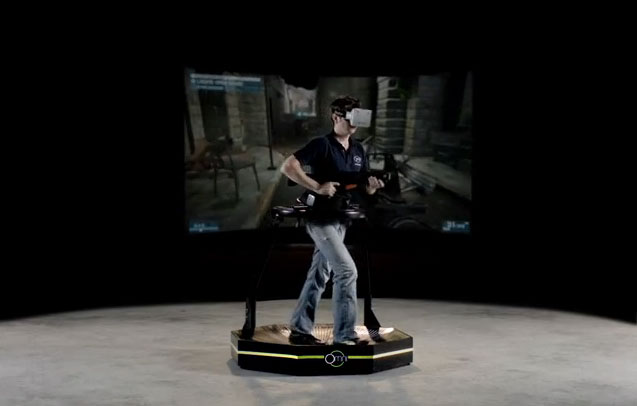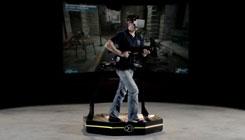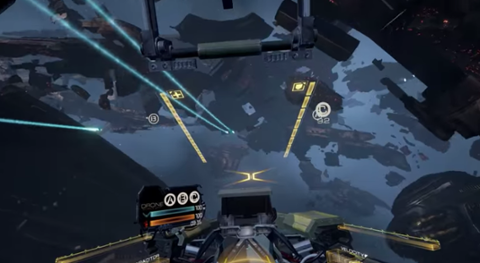 When virtual reality (VR) first became a buzzword in the early 90’s, we seemed destined for a world full of headsets and totally immersive content – then that future evaporated and we were left with naught but bitter disappointment. What happened? Early VR systems suffered from three fatal flaws: They were really heavy, really expensive and there was a serious lack of applicable content. The impact was never in question, the reactions of attendees of “fine art” installations by earlier pioneers like Char Davies demonstrated that. But equipment costs limited the number of people that could view their work. The technology was not ready for prime time and manufacturers took a step back. Now, we're seeing a resurgence, which is noteworthy because it has not, for the most part, been driven by conventional hardware sources. While VR conjures up a range of connotations, I'd argue that it takes more than a headset to create a complete virtual experience. Granted, sight and sound are perhaps our most important senses when it comes to taking in simulated environments, but our means of interaction with the virtual are crucial to the overall experience. At the very least, that means we need a headset and some sort of motion sensing technology. The latter gets a little tricky, because moving about with a headset strapped in front of your face could easily make for an expensive accident – thus the range of the user’s physical movements needs to be limited without restricting their range of motion. The success of the Oculus Rift on Kickstarter could be said to be proof that the gaming masses have been wanting in the VR department. While a consumer version of the headset has yet to hit the market, there are enough developer models around to gauge the general response – overwhelming would be something of an exaggeration, but developers do seem, for the most part, to be very satisfied. At 379 grams (not counting headphones), the headset is light enough to wear for extended periods of time. With the second version of the headset, which is aimed at consumers, developers are looking to improve head and weapon tracking and the screen resolution. The most significant complaint, that the so called “screen door effect" was very noticeable on the first version of the Rift was, for the most part, ironed out in the developer model. Ramping up to a higher definition display, as is expected with version 2.0, with better pixel fill would go a long way towards mitigating this and achieving a level of visual clarity, which would significantly broaden its appeal. Headset technology has always been the biggest obstacle to VR adoption. The weight and cost issues that made early models either unimpressive or prohibitively expensive have largely been overcome. The magic comes from a Hillcrest 3DoF head tracker with custom firmware that allows it to run at 250Hz. Coupled with 3-axis gyros, accelerometers and magnetometers, it's able to display a fairly detailed artificial environment that a user can look around fairly quickly without experiencing motion blur. It's not perfect, but it's almost there – and more importantly, it's almost there at a price that most people will be able to afford. While there have been no official announcements with regard to the retail price, it's widely rumored to be close to $300. Now that the Oculus Rift is nearing launch, we're starting to see the emergence of crowdfunded third-party accessories that aim to boost the Rift experience. At this stage, I'd opine that it's a little too early to start introducing peripherals that fall outside of the core virtual experience: sight, sound and movement. A force feedback vest popped up recently, but doesn't look like it will be successfully funded. So what of the movement side of the equation? That actually comes to us from two sources – one of which is, not surprisingly, Microsoft’s Kinect. The other is the Virtuix Omni, a VR treadmill that is able to translate steps into virtual-world movements. The technology itself is relatively simple: a multi-directional treadmill that uses accelerometers and magnetometers to translate a user’s treadmill walking/running into realistic in-game movement. Other design features largely involve solving the problem of keeping the user upright. At present, the Omni is still in the funding stage, but it has attracted a good deal of attention, enough so that it blitzed past its $150,000 funding goal on its first day on Kickstarter. There is, as of yet, no word on the retail price – Virtuix has stated that its goal is to get the Omni into the hands of as many developers as possible, and that the price of the finished product is likely to be significantly higher than the Kickstarter price of $400. The Omni is not, however, a complete solution to in-game movement. It will let you walk and run without falling over, but it doesn't track other body movements – to throw that level of sensitivity into the ring you need the Kinect. The Kinect effectively solves the last piece of the movement puzzle and frees the user from the tyranny of the keyboard or the need for a hand held controller. With the Kinect you can translate any number of real-world actions into virtual-world movements and enter your VR environment empty handed. The second-generation Kinect will be Windows compatible, which should mean that we start to see movement tracking technology make its way into a wider range of games – and into first person shooter territory, which probably stands to gain the most from the Oculus Rift. At present there is no official price for the Kinect 2. When the first version hit the market it was priced at $150, since reduced to $110, and that would seem to be a reasonable price point at which to aim. So where does this leave us? In the early days of VR, a complete system would have cost tens of thousands of dollars. Even as recently as 2006, according to a report from TechCast, one would have been looking at spending no less than $5,000. Interestingly, the author of that report suggested that mainstream adoption of VR would not happen until 2020. The report paints a clear picture of where the industry was seven years ago. Nobody was predicting the proliferation of mainstream VR in less than a decade – and nobody had heard of crowdfunding. At present, it would cost less than $1,000 to acquire all of the peripherals needed to create a functional VR unit, assuming that the user already has a PC. With the relative affordability of the soon-to-be released VR technology, we can expect it to make a splash in the gaming industry in the not too distant future. Given that all of the core components are currently in the production stage, it would be unlikely to see anything too spectacular before the end of the year. But from 2014 on, VR is almost certain to gain significant traction.
When virtual reality (VR) first became a buzzword in the early 90’s, we seemed destined for a world full of headsets and totally immersive content – then that future evaporated and we were left with naught but bitter disappointment. What happened? Early VR systems suffered from three fatal flaws: They were really heavy, really expensive and there was a serious lack of applicable content. The impact was never in question, the reactions of attendees of “fine art” installations by earlier pioneers like Char Davies demonstrated that. But equipment costs limited the number of people that could view their work. The technology was not ready for prime time and manufacturers took a step back. Now, we're seeing a resurgence, which is noteworthy because it has not, for the most part, been driven by conventional hardware sources. While VR conjures up a range of connotations, I'd argue that it takes more than a headset to create a complete virtual experience. Granted, sight and sound are perhaps our most important senses when it comes to taking in simulated environments, but our means of interaction with the virtual are crucial to the overall experience. At the very least, that means we need a headset and some sort of motion sensing technology. The latter gets a little tricky, because moving about with a headset strapped in front of your face could easily make for an expensive accident – thus the range of the user’s physical movements needs to be limited without restricting their range of motion. The success of the Oculus Rift on Kickstarter could be said to be proof that the gaming masses have been wanting in the VR department. While a consumer version of the headset has yet to hit the market, there are enough developer models around to gauge the general response – overwhelming would be something of an exaggeration, but developers do seem, for the most part, to be very satisfied. At 379 grams (not counting headphones), the headset is light enough to wear for extended periods of time. With the second version of the headset, which is aimed at consumers, developers are looking to improve head and weapon tracking and the screen resolution. The most significant complaint, that the so called “screen door effect" was very noticeable on the first version of the Rift was, for the most part, ironed out in the developer model. Ramping up to a higher definition display, as is expected with version 2.0, with better pixel fill would go a long way towards mitigating this and achieving a level of visual clarity, which would significantly broaden its appeal. Headset technology has always been the biggest obstacle to VR adoption. The weight and cost issues that made early models either unimpressive or prohibitively expensive have largely been overcome. The magic comes from a Hillcrest 3DoF head tracker with custom firmware that allows it to run at 250Hz. Coupled with 3-axis gyros, accelerometers and magnetometers, it's able to display a fairly detailed artificial environment that a user can look around fairly quickly without experiencing motion blur. It's not perfect, but it's almost there – and more importantly, it's almost there at a price that most people will be able to afford. While there have been no official announcements with regard to the retail price, it's widely rumored to be close to $300. Now that the Oculus Rift is nearing launch, we're starting to see the emergence of crowdfunded third-party accessories that aim to boost the Rift experience. At this stage, I'd opine that it's a little too early to start introducing peripherals that fall outside of the core virtual experience: sight, sound and movement. A force feedback vest popped up recently, but doesn't look like it will be successfully funded. So what of the movement side of the equation? That actually comes to us from two sources – one of which is, not surprisingly, Microsoft’s Kinect. The other is the Virtuix Omni, a VR treadmill that is able to translate steps into virtual-world movements. The technology itself is relatively simple: a multi-directional treadmill that uses accelerometers and magnetometers to translate a user’s treadmill walking/running into realistic in-game movement. Other design features largely involve solving the problem of keeping the user upright. At present, the Omni is still in the funding stage, but it has attracted a good deal of attention, enough so that it blitzed past its $150,000 funding goal on its first day on Kickstarter. There is, as of yet, no word on the retail price – Virtuix has stated that its goal is to get the Omni into the hands of as many developers as possible, and that the price of the finished product is likely to be significantly higher than the Kickstarter price of $400. The Omni is not, however, a complete solution to in-game movement. It will let you walk and run without falling over, but it doesn't track other body movements – to throw that level of sensitivity into the ring you need the Kinect. The Kinect effectively solves the last piece of the movement puzzle and frees the user from the tyranny of the keyboard or the need for a hand held controller. With the Kinect you can translate any number of real-world actions into virtual-world movements and enter your VR environment empty handed. The second-generation Kinect will be Windows compatible, which should mean that we start to see movement tracking technology make its way into a wider range of games – and into first person shooter territory, which probably stands to gain the most from the Oculus Rift. At present there is no official price for the Kinect 2. When the first version hit the market it was priced at $150, since reduced to $110, and that would seem to be a reasonable price point at which to aim. So where does this leave us? In the early days of VR, a complete system would have cost tens of thousands of dollars. Even as recently as 2006, according to a report from TechCast, one would have been looking at spending no less than $5,000. Interestingly, the author of that report suggested that mainstream adoption of VR would not happen until 2020. The report paints a clear picture of where the industry was seven years ago. Nobody was predicting the proliferation of mainstream VR in less than a decade – and nobody had heard of crowdfunding. At present, it would cost less than $1,000 to acquire all of the peripherals needed to create a functional VR unit, assuming that the user already has a PC. With the relative affordability of the soon-to-be released VR technology, we can expect it to make a splash in the gaming industry in the not too distant future. Given that all of the core components are currently in the production stage, it would be unlikely to see anything too spectacular before the end of the year. But from 2014 on, VR is almost certain to gain significant traction. Get Ready for a Virtual Future
 When virtual reality (VR) first became a buzzword in the early 90’s, we seemed destined for a world full of headsets and totally immersive content – then that future evaporated and we were left with naught but bitter disappointment. What happened? Early VR systems suffered from three fatal flaws: They were really heavy, really expensive and there was a serious lack of applicable content. The impact was never in question, the reactions of attendees of “fine art” installations by earlier pioneers like Char Davies demonstrated that. But equipment costs limited the number of people that could view their work. The technology was not ready for prime time and manufacturers took a step back. Now, we're seeing a resurgence, which is noteworthy because it has not, for the most part, been driven by conventional hardware sources. While VR conjures up a range of connotations, I'd argue that it takes more than a headset to create a complete virtual experience. Granted, sight and sound are perhaps our most important senses when it comes to taking in simulated environments, but our means of interaction with the virtual are crucial to the overall experience. At the very least, that means we need a headset and some sort of motion sensing technology. The latter gets a little tricky, because moving about with a headset strapped in front of your face could easily make for an expensive accident – thus the range of the user’s physical movements needs to be limited without restricting their range of motion. The success of the Oculus Rift on Kickstarter could be said to be proof that the gaming masses have been wanting in the VR department. While a consumer version of the headset has yet to hit the market, there are enough developer models around to gauge the general response – overwhelming would be something of an exaggeration, but developers do seem, for the most part, to be very satisfied. At 379 grams (not counting headphones), the headset is light enough to wear for extended periods of time. With the second version of the headset, which is aimed at consumers, developers are looking to improve head and weapon tracking and the screen resolution. The most significant complaint, that the so called “screen door effect" was very noticeable on the first version of the Rift was, for the most part, ironed out in the developer model. Ramping up to a higher definition display, as is expected with version 2.0, with better pixel fill would go a long way towards mitigating this and achieving a level of visual clarity, which would significantly broaden its appeal. Headset technology has always been the biggest obstacle to VR adoption. The weight and cost issues that made early models either unimpressive or prohibitively expensive have largely been overcome. The magic comes from a Hillcrest 3DoF head tracker with custom firmware that allows it to run at 250Hz. Coupled with 3-axis gyros, accelerometers and magnetometers, it's able to display a fairly detailed artificial environment that a user can look around fairly quickly without experiencing motion blur. It's not perfect, but it's almost there – and more importantly, it's almost there at a price that most people will be able to afford. While there have been no official announcements with regard to the retail price, it's widely rumored to be close to $300. Now that the Oculus Rift is nearing launch, we're starting to see the emergence of crowdfunded third-party accessories that aim to boost the Rift experience. At this stage, I'd opine that it's a little too early to start introducing peripherals that fall outside of the core virtual experience: sight, sound and movement. A force feedback vest popped up recently, but doesn't look like it will be successfully funded. So what of the movement side of the equation? That actually comes to us from two sources – one of which is, not surprisingly, Microsoft’s Kinect. The other is the Virtuix Omni, a VR treadmill that is able to translate steps into virtual-world movements. The technology itself is relatively simple: a multi-directional treadmill that uses accelerometers and magnetometers to translate a user’s treadmill walking/running into realistic in-game movement. Other design features largely involve solving the problem of keeping the user upright. At present, the Omni is still in the funding stage, but it has attracted a good deal of attention, enough so that it blitzed past its $150,000 funding goal on its first day on Kickstarter. There is, as of yet, no word on the retail price – Virtuix has stated that its goal is to get the Omni into the hands of as many developers as possible, and that the price of the finished product is likely to be significantly higher than the Kickstarter price of $400. The Omni is not, however, a complete solution to in-game movement. It will let you walk and run without falling over, but it doesn't track other body movements – to throw that level of sensitivity into the ring you need the Kinect. The Kinect effectively solves the last piece of the movement puzzle and frees the user from the tyranny of the keyboard or the need for a hand held controller. With the Kinect you can translate any number of real-world actions into virtual-world movements and enter your VR environment empty handed. The second-generation Kinect will be Windows compatible, which should mean that we start to see movement tracking technology make its way into a wider range of games – and into first person shooter territory, which probably stands to gain the most from the Oculus Rift. At present there is no official price for the Kinect 2. When the first version hit the market it was priced at $150, since reduced to $110, and that would seem to be a reasonable price point at which to aim. So where does this leave us? In the early days of VR, a complete system would have cost tens of thousands of dollars. Even as recently as 2006, according to a report from TechCast, one would have been looking at spending no less than $5,000. Interestingly, the author of that report suggested that mainstream adoption of VR would not happen until 2020. The report paints a clear picture of where the industry was seven years ago. Nobody was predicting the proliferation of mainstream VR in less than a decade – and nobody had heard of crowdfunding. At present, it would cost less than $1,000 to acquire all of the peripherals needed to create a functional VR unit, assuming that the user already has a PC. With the relative affordability of the soon-to-be released VR technology, we can expect it to make a splash in the gaming industry in the not too distant future. Given that all of the core components are currently in the production stage, it would be unlikely to see anything too spectacular before the end of the year. But from 2014 on, VR is almost certain to gain significant traction.
When virtual reality (VR) first became a buzzword in the early 90’s, we seemed destined for a world full of headsets and totally immersive content – then that future evaporated and we were left with naught but bitter disappointment. What happened? Early VR systems suffered from three fatal flaws: They were really heavy, really expensive and there was a serious lack of applicable content. The impact was never in question, the reactions of attendees of “fine art” installations by earlier pioneers like Char Davies demonstrated that. But equipment costs limited the number of people that could view their work. The technology was not ready for prime time and manufacturers took a step back. Now, we're seeing a resurgence, which is noteworthy because it has not, for the most part, been driven by conventional hardware sources. While VR conjures up a range of connotations, I'd argue that it takes more than a headset to create a complete virtual experience. Granted, sight and sound are perhaps our most important senses when it comes to taking in simulated environments, but our means of interaction with the virtual are crucial to the overall experience. At the very least, that means we need a headset and some sort of motion sensing technology. The latter gets a little tricky, because moving about with a headset strapped in front of your face could easily make for an expensive accident – thus the range of the user’s physical movements needs to be limited without restricting their range of motion. The success of the Oculus Rift on Kickstarter could be said to be proof that the gaming masses have been wanting in the VR department. While a consumer version of the headset has yet to hit the market, there are enough developer models around to gauge the general response – overwhelming would be something of an exaggeration, but developers do seem, for the most part, to be very satisfied. At 379 grams (not counting headphones), the headset is light enough to wear for extended periods of time. With the second version of the headset, which is aimed at consumers, developers are looking to improve head and weapon tracking and the screen resolution. The most significant complaint, that the so called “screen door effect" was very noticeable on the first version of the Rift was, for the most part, ironed out in the developer model. Ramping up to a higher definition display, as is expected with version 2.0, with better pixel fill would go a long way towards mitigating this and achieving a level of visual clarity, which would significantly broaden its appeal. Headset technology has always been the biggest obstacle to VR adoption. The weight and cost issues that made early models either unimpressive or prohibitively expensive have largely been overcome. The magic comes from a Hillcrest 3DoF head tracker with custom firmware that allows it to run at 250Hz. Coupled with 3-axis gyros, accelerometers and magnetometers, it's able to display a fairly detailed artificial environment that a user can look around fairly quickly without experiencing motion blur. It's not perfect, but it's almost there – and more importantly, it's almost there at a price that most people will be able to afford. While there have been no official announcements with regard to the retail price, it's widely rumored to be close to $300. Now that the Oculus Rift is nearing launch, we're starting to see the emergence of crowdfunded third-party accessories that aim to boost the Rift experience. At this stage, I'd opine that it's a little too early to start introducing peripherals that fall outside of the core virtual experience: sight, sound and movement. A force feedback vest popped up recently, but doesn't look like it will be successfully funded. So what of the movement side of the equation? That actually comes to us from two sources – one of which is, not surprisingly, Microsoft’s Kinect. The other is the Virtuix Omni, a VR treadmill that is able to translate steps into virtual-world movements. The technology itself is relatively simple: a multi-directional treadmill that uses accelerometers and magnetometers to translate a user’s treadmill walking/running into realistic in-game movement. Other design features largely involve solving the problem of keeping the user upright. At present, the Omni is still in the funding stage, but it has attracted a good deal of attention, enough so that it blitzed past its $150,000 funding goal on its first day on Kickstarter. There is, as of yet, no word on the retail price – Virtuix has stated that its goal is to get the Omni into the hands of as many developers as possible, and that the price of the finished product is likely to be significantly higher than the Kickstarter price of $400. The Omni is not, however, a complete solution to in-game movement. It will let you walk and run without falling over, but it doesn't track other body movements – to throw that level of sensitivity into the ring you need the Kinect. The Kinect effectively solves the last piece of the movement puzzle and frees the user from the tyranny of the keyboard or the need for a hand held controller. With the Kinect you can translate any number of real-world actions into virtual-world movements and enter your VR environment empty handed. The second-generation Kinect will be Windows compatible, which should mean that we start to see movement tracking technology make its way into a wider range of games – and into first person shooter territory, which probably stands to gain the most from the Oculus Rift. At present there is no official price for the Kinect 2. When the first version hit the market it was priced at $150, since reduced to $110, and that would seem to be a reasonable price point at which to aim. So where does this leave us? In the early days of VR, a complete system would have cost tens of thousands of dollars. Even as recently as 2006, according to a report from TechCast, one would have been looking at spending no less than $5,000. Interestingly, the author of that report suggested that mainstream adoption of VR would not happen until 2020. The report paints a clear picture of where the industry was seven years ago. Nobody was predicting the proliferation of mainstream VR in less than a decade – and nobody had heard of crowdfunding. At present, it would cost less than $1,000 to acquire all of the peripherals needed to create a functional VR unit, assuming that the user already has a PC. With the relative affordability of the soon-to-be released VR technology, we can expect it to make a splash in the gaming industry in the not too distant future. Given that all of the core components are currently in the production stage, it would be unlikely to see anything too spectacular before the end of the year. But from 2014 on, VR is almost certain to gain significant traction. 


